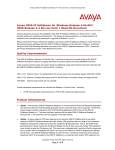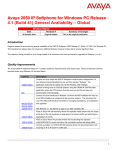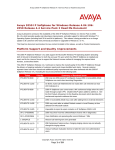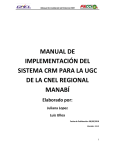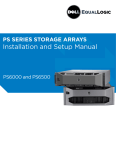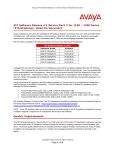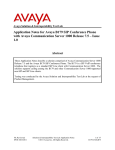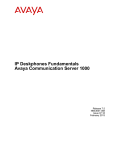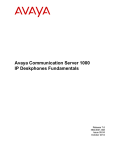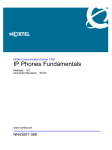Download Avaya 2050 IP Softphone Release 4.4 Service Pack 3 User's Manual
Transcript
Avaya 2050 IP Softphone Release 4.4 Service Pack 3 Readme Document Avaya 2050 IP Softphone for Windows Release 4.04.132: 2050 Release 4.4 Service Pack 3 Read Me Document Avaya is pleased to announce the availability of the 2050 IP Softphone Release 4.4 Service Pack 3 (2050 R4.4.3), which provides quality and robustness improvements, and support for the SHA 256 hash algorithm for enhanced security. This release is being provided as a no charge update to all customers who have previously purchased or upgraded to Release 3.x or 4.x. This Read me document summarizes the new content included in this release, as well as Product Advisements. Platform Support and Quality Improvements The 2050 IP Softphone Release 4.4.3 adds support SHA 256 hash algorithm in accordance with recommendations of NIST. Please, note that CS1000 does not support SHA 256 without R7.6 SP5. This 2050 IP Softphone Release 4.4.3 continues to improve the overall quality of the 2050 IP Softphone through the delivery of ongoing resolution of customer reports and Avaya identified work items. Several customers reported cases have been closed and additional quality improvements have been delivered with this 2050 IP Softphone Release 4.4.3 including the issues documented in the following table. Ticket Priority Summary of Resolved Issue IPCLIENTS-11592 P2 I2050 is suspended when user verify Print information of Hot keys window for a long time. IPCLIENTS-11530 P2 Phone may crash after sorting new LDAP/Outlook contacts with customized view IPCLIENTS-11527 P2 The i2050 softphone (MED) cannot install successfully after user Uninstalled normal load IPCLIENTS-11524 P2 The i2050 softphone may crash after user switches between two profiles quickly with EM IPCLIENTS-11515 P2 i2050 may crash after user press “Return” from “Ping” IP in “Network Diagnostic Tools” in Local Menu IPCLIENTS-11665 P3 Mute option in Sound Devices is auto-checked when creating new profile IPCLIENTS-11580 P3 I2050 cannot get any configuration files on provisioning server with 0XX.0XX.0XX.0XX IP format. IPCLIENTS-11573 P3 Filter wrongly contacts in Local Directory with multi conditions. IPCLIENTS-11529 P3 "Sort By Email Address" does not work for LDAP contacts IPCLIENTS-11528 P3 Default search does not display actual results for LDAP/Outlook contacts IPCLIENTS-11523 P3 Some pages in IP Softphone Settings are disappeared after choosing a contact in Outlook Directory. IPCLIENTS-11520 P3 Default Dial does not save the configuration before after changing some information in General tab Copyright Avaya 2013 All rights reserved Page 1 of 11 Avaya 2050 IP Softphone Release 4.4 Service Pack 3 Readme Document IPCLIENTS-11519 P3 SR#1-4306054514(KPN Corporate Market B.V.)Can't save audio setting of 2050PC to pc with local user rights IPCLIENTS-11517 P3 Non-default fields are not displayed for contacts on Outlook/LDAP directories IPCLIENTS-11516 P3 i2050 softphone cannot Tracert in Network Diagnostic Tools IPCLIENTS-11514 P3 The message “Data Truncated” is shown when pressing Local Directory on Shortcut Bar IPCLIENTS-11482 P3 2050PC: Voice notifications works incorrectly when switching profiles IPCLIENTS-11476 P3 Audio volume for new profile should be a non-zero value IPCLIENTS-11468 P3 2050PC: Call Contact button in Outlook directory works incorrectly IPCLIENTS-11451 P3 2050PC: The icon of hold call is not shown in Accessibility mode IPCLIENTS-11438 P3 Status of incoming call is displayed incorrectly when its accessibility interface is overlapped by Diagnostic window IPCLIENTS-11430 P3 Phone does not automatically re-display contacts after invalid database is imported IPCLIENTS-11278 P3 2050 IP Softphone – I2050 does not replace the existing file. IPCLIENTS-11254 P3 After hibernation in Windows 2050 softphone shows black box. IPCLIENTS-8298 P3 Warning message show when make calls properly using TAPI compliant applications on Windows. IPCLIENTS-11633 P4 Short keys do not work on EM. IPCLIENTS-11453 P4 2050PC: The information of OS name is shown incorrectly in Diagnostics IPCLIENTS-8900 P4 Cancel is not translated on the pop up when reset Hardware ID. Copyright Avaya 2013 All rights reserved Page 2 of 11 Avaya 2050 IP Softphone Release 4.4 Service Pack 3 Readme Document Product Advisements • An issue related to VPN was observed on the 2050 IP Softphone R4.4 and earlier releases of 2050 IP Softphone where users with Juniper VPN equipment were not able to join Conference Bridges by pressing the number pad to input the Conference Bridge password. That is, the DTMF tones generated did not seem to get to the Conference Bridge and due to that, users with Juniper VPN equipment were not able to enter the Conference call. This issue was investigated and it was found that the cause was due to Juniper VPN incompatibility with DSCP, and as such all releases of 2050 IP Softphone are affected by this issue. The 2050 IP Softphone Release 4.4 Service Pack 1 and higher includes a workaround to this issue by allowing to DSCP to be disabled in the 2050 IP Softphone, so customers with Juniper VPN equipment can now upgrade to this latest release and use the workaround. See the picture below that shows how the new option ‘Disable DSCP’ has been added into the bottom of the Server page in 2050 IP Softphone Settings menu. The option is unchecked by default. Use the checkbox to disable applying DSCP bits in IP packets. • Although the 2050 IP Softphone Rls 4.4 Service Pack 1 and higher natively supports Windows Vista and Windows 7, it could be started in Windows XP compatibility mode. Please note, that this mode is not supported and could cause speech path issues or problems with USB headset detection. Therefore it is recommended to disable Windows XP compatibility mode in Windows Vista / Windows 7. • This 2050 IP Softphone Release 4.4 Service Pack 3 may be installed over an existing installation of the 2050 IP Softphone. All user settings, licenses, etc will be retained. Note that if the customer chooses to use MSI installer over EXE, the install process will not clean up the “2050 IP Softphone Extra Modules” component. The customer may do that manually via the Control Panel Add or Remove Programs on Windows XP, or, via the Control PanelProgramsPrograms and Features on Vista and Windows 7. • User should install and configure Outlook for Window OS first before launching i2050 and link to Outlook Directory. Copyright Avaya 2013 All rights reserved Page 3 of 11 Avaya 2050 IP Softphone Release 4.4 Service Pack 3 Readme Document • A warning message can appear when the 2050 IP Softphone is started using a new Regular User account, if the new account has been installed on the PC for the first time with an Administrator account using the msi installer method. The 2050 IP Softphone is able to recover itself if any components, files, or registry keys have been accidentally removed or corrupted. On every start, the 2050 IP Softphone checks its vital components. If they are missing, the Softphone tries to reinstall them using its installation files. This feature works only if the original installation files are accessible for the user who launched the Softphone. If the 2050 IP Softphone was installed on behalf of a different user account, some components may not be properly registered for the current user. In this case the 2050 IP Softphone will try to setup these components at first startup. The following message will appear at the end. Reboot action is not required in such a case and can be skipped by pressing the ‘Cancel’ button. If the original installation files are NOT accessible for this user, the recover action cannot be completed and the message will reappear. To resolve this, the user needs to make the installation files available for this user profile or the Softphone should be reinstalled for this particular user account. Supported Platforms Operating Systems • Microsoft® Windows XP™ (Service Pack 3) • Microsoft® Windows Vista™ (Service Pack 1) – 32 bit and 64 bit versions • Microsoft® Windows 7™ – 32 bit and 64 bit versions • Microsoft® Windows 8™ - 32 bit and 64 bit versions Call Server Compatibility and Requirements The 2050 IP Softphone Release 4.4.3 is compatible with the Avaya Call Servers listed below. Avaya CS1000: Release 6.0, 7.0, 7.5, 7.6 (See Note 1) Avaya BCM 50: Release 6.0 (See Note 2) Avaya BCM450: Release 6.0 (See Note 2) Avaya SRG 50: Release 6.0 (See Note 3) Note 1: Both CS1000 R6.0 and R7.0 are End of Manufacture Support for software; R7.5 will be End of Manufacture th Support from 24 September 2013. Copyright Avaya 2013 All rights reserved Page 4 of 11 Avaya 2050 IP Softphone Release 4.4 Service Pack 3 Readme Document Note 2: BCM Release 6.0 or higher is required for Caller ID information to be displayed in the incoming pop-up window as well as support of the Soft-Expansion Module functionality. Note that BCM 450 is End of Sale but software upgrades will be supported under Avaya discretion. Note 3: In SRG Local mode only three out of six programmable keys will be active. Software Download The 2050 IP Softphone Release 4.4.3 for Windows PC is generally available globally as of April 7, 2014. The 2050 IP Softphone Release 4.4.3 is available for download from http://support.avaya.com. Select “Downloads & Documents’, and then enter the product name "2050 IP Softphone’. Choose “2050 IP Softphone for Windows PC Release 4.4 Service Pack 3 (Build 132) to access the software files and Read Me document. The following files are available for download with the Release: File Description 4.0x.xxx-all.zip (4.04.132-all.zip) All installation files. setup_xxxxxx.msi (setup_404132.msi) 2050 IP Softphone installation file in Microsoft Windows Manager Installation file (msi) format. setup_xxxxxx.exe (setup_404132.exe) 2050 IP Deskphone installation file in setup.exe format. setup_server.exe License Server software setup file. i2050 ConfigurationTool.exe Utility for creation of profile settings to enable rapid deployment of the 2050 IP Softphone on user desktops. i2050GetHWIDTool.exe Tool for obtaining the Hardware ID used in the creation of licenses. IPSoftphone2050_Settings.exe A utility that can be run to configure the 2050 IP Softphone Country specific software files for Russia, Belarus, and Kazakhstan markets only 4.04.132-all-NE.zip Version of 2050 IP Softphone containing no media encryption – for Russia, Belarus, and Kazakhstan markets only. Setup_NoMediaEncryption_404132.msi 2050 IP Softphone Installation file in Microsoft Windows Manager Installation file (msi) format. This version is for use in Russia, Belarus, and Kazakhstan only. Setup_NoMediaEncryption_404132.exe 2050 IP Softphone Installation file in setup.exe format. This version is for use in Russia, Belarus, and Kazakhstan only. Copyright Avaya 2013 All rights reserved Page 5 of 11 Avaya 2050 IP Softphone Release 4.4 Service Pack 3 Readme Document This release is being provided as a no charge update to all customers who have purchased or upgraded to Release 3.x or 4.x. License Ordering Guidelines and Procedures Software licensing was introduced with the 2050 IP Softphone Release 3.0. Software licensing eliminates the requirement to purchase a CDROM copy of the 2050 IP Softphone Release 3.0 client application on a perdesktop basis. Instead, Right-to-Use Licenses are purchased from Avaya’s Keycode Retrieval System (KRS) which is accessible via the Avaya Support Portal at the link below: http://support.avaya.com/krs Additional information on generating and retrieving keycodes is provided in a later section of this Readme document, and is included in Product Documentation (See Communication Server 1000 IP Phone Fundamentals, NN43001-368). Software licensing is based on either a ‘per-user’ (nodal) approach, or a ‘pool-of-users’ (Licensing Server) approach. The per-user nodal approach is loaded onto an individual PC for sole use of that user, and requires the12-digit Media Access Control (MAC) address of the network adapter upon which the 2050 IP Softphone application will be installed, to be entered into the Avaya KRS system to generate the license. See the instructions below on how to generate node-based licenses for the 2050 IP Softphone. For the Licensing Server approach, a ‘pool-of-users’ method is used, and provides increased cost-effectiveness for some customers. For example, if a customer has identified that they have 100 active users of the 2050 IP Softphone at any given time, out of a total population of 500 2050 IP Softphone users, they should plan on purchasing 100 (or more) licenses to support their employees. An active (or ‘checked out’) license is required in order to make a call with the 2050 IP Softphone. Licenses are hosted on a Licensing Server, which is a customer supplied PC and is located on the customer premise. Note that support for Microsoft Windows 8 extends to the Licensing Server as well. Two order codes are established with 2050 IP Softphone. There is a ‘Right-to-Use (RTU) license for new 2050 IP Softphone Release 4.4x purchases. An upgrade Right-to-Use license has been established offering a discount for installed base customers of Release 1.x and 2.x wishing to upgrade to Release 4.x. New Purchases: PEC Description NTDW84BA 2050 IP Softphone New User License (Release 3.x or 4.x) Upgrades from 2050 IP Softphone Release 1.x / 2.x to Release 4.4 PEC Description NTDW84CA 2050 IP Softphone Upgrade License from Release 1 and 2 Note: The Software CD Package will not be available for the 2050 IP Softphone Release 4.0 and higher. The full release is available for download from the Avaya Support Web site and KRS. Refer to the following section, or to the User Documentation, for additional details. Customers who have previously purchased and installed an earlier version of 2050 IP Softphone may download this Release 4.4x from the Avaya Support portal using their existing licensing. Please refer to the following section. Copyright Avaya 2013 All rights reserved Page 6 of 11 Avaya 2050 IP Softphone Release 4.4 Service Pack 3 Readme Document Keycode Retrieval Process from KRS The 2050 IP Softphone requires a license in order to operate. Upon initial installation, the application will enter into a 30-day ‘grace period’ which allows users 30 days to obtain the licensing keycode. The grace period may not be extended. Before proceeding with obtaining keycodes via the KRS system, you must have the following information available: • If using Node-locked licenses, the 12-digit Media Access Control (MAC) address of the network adapter upon which the 2050 IP Softphone application will be installed, is required. If the PC contains multiple adapters, the i2050GetHWID.exe utility (available with the 2050 IP Softphone release software package) may be used to obtain the MAC address that will be used by the 2050. The Hardware ID (available through the Diagnostics screen) may also be used as it contains the MAC address. The Hardware ID is a 20-digit ID in the format: 31-32-XX-XX-XX-XX-XX-XX-66-06 where the middle XX digits are the MAC address and the first 4 digits and last 4 digits are the same for all 2050 IP Softphone instances. If multiple Node-locked licenses are desired, these can be created at the same time. KRS will accept a list of the MAC addresses in a text file in a comma separated value (CSV) format. Please refer to the section below, or the User Documentation, for the procedure on registering and generating Node-locked licenses for the 2050 IP Softphone. • If using a Network Licensing Server, for a ‘pool-of-users’ approach, the Fully Qualified Domain Name (FQDN) of the PC on which the License Server Software is installed is required. The FQDN must be in a dotted decimal format, for example: yourlicenseserver1.yourcompany.com. The 2050 IP Softphone License Server Software can be pre-installed and used to determine the FQDN of the PC using the gethostid.exe utility. • Purchase Order Number Procedure for Registering / Generating Node–locked or Licensing Server-based keycodes for the 2050 IP Softphone: 1. 2. 3. 4. 5. Access the KRS site at: http://support.avaya.com/krs Select ‘KRS Site’ at the bottom of the page, under RELATED LINKS At Step 1, Select ‘Global Login’ At Step 2, Select product family ‘2050 IP Softphone’, Click GO Enter Login credentials. Note: The KRS User Guide provides detailed, up-to-date instructions for using the KRS system to create keycodes for the 2050 IP Softphones. To access the KRS User Guide, click on ‘Documentation Forms & USER GUIDES’ on the left sidebar. 6. 7. 8. Click on ‘Product Registration’ on the sidebar. Enter a unique name for the Site Name Enter the System ID. For Node-locked licenses, this is the MAC address. For Network Licensing Server, this is the FQDN. 9. Click ‘Create’. 10. Click on ‘Generate Keycode’ on the sidebar 11. At Step 1, enter the Host ID into the Enter HostID field. (Note the HostID is the host name of the PC where the license server is installed, e.g. win2008server.somecompany.com) 12. At Step 2, enter the Purchase Order Number*. Alternatively, you can search by Avaya Order #, COEO, Customer PO#, or Alternate Order #. Copyright Avaya 2013 All rights reserved Page 7 of 11 Avaya 2050 IP Softphone Release 4.4 Service Pack 3 Readme Document * Assuming a purchase order has been placed for a number of users, SAP will have created a non-stock PO and will send to KRS. Note: COEO = Common Equipment Order Number for carrier customers. Authorization codes are used by Stocking Distributors. 13. At Step 3, select the quantity / number of licenses desired. 14. Click ‘Continue’. The program then returns back to the Select PO screen to allow users to pull licenses from multiple PO’s if desired. 15. Click ‘Go to Summary’ 16. Click ‘Generate Keycode’. A new keycode is generated in the KRS database. The user is then directed to the Keycode Retrieve screen. 17. Select ‘Download Keycode and apply to System’. The license is saved as a .lic file on the local system. Expansions: 1. 2. 3. 4. 5. Click on ‘Generate Keycode’ on the sidebar. At Step 1, enter the Host ID from the previous step into the Enter HostID field. At Step 2, enter the Purchase Order Number to pull the license entitlement form At Step 3, enter the quantity / number of additional seats required. Click ‘Generate Keycode’. Note: With the 2050 IP Softphone, each license increment generates an additional license file. This is different from other products where a single license file is revised to include the additional values. If you are experiencing any problems with the KRS system, click on the CONTACT KRS SUPPORT link at the bottom of the page. Some of the documents may include Product Bulletins, Sales and Marketing Bulletins, and NTPs. References and Related Documents The following documents are associated with 2050 IP Softphone for Windows PC on the CS1000: Communication Server 1000 IP Phone Fundamentals, NN43001-368 2050 IP Softphone User Guide, NN43119-101 2050 IP Softphone Call Center User Guide, NN43119-100 These CS1000 documents can be found on the Avaya Support Portal at: http://support.avaya.com At the top, select Downloads & Documentation and enter ‘2050 IP Softphone’ in the product selection box. This will provide a list of all the Administration and System Programming documents, and User Guides in multiple languages for use with the different supported Avaya Call Servers. License Agreements W3C(r) SOFTWARE NOTICE AND LICENSE Copyright (c) 1994-2002 World Wide Web Consortium, (Massachusetts Institute of Technology, Institut National de Recherche en Informatique et en Automatique, Keio University). All Rights Reserved. http://www.w3.org/Consortium/Legal/ Copyright Avaya 2013 All rights reserved Page 8 of 11 Avaya 2050 IP Softphone Release 4.4 Service Pack 3 Readme Document This W3C work (including software, documents, or other related items) is being provided by the copyright holders under the following license. By obtaining, using and/or copying this work, you (the licensee) agree that you have read, understood, and will comply with the following terms and conditions: Permission to use, copy, modify, and distribute this software and its documentation, with or without modification, for any purpose and without fee or royalty is hereby granted, provided that you include the following on ALL copies of the software and documentation or portions thereof, including modifications, that you make: The full text of this NOTICE in a location viewable to users of the redistributed or derivative work. Any pre-existing intellectual property disclaimers, notices, or terms and conditions. If none exist, a short notice of the following form (hypertext is preferred, text is permitted) should be used within the body of any redistributed or derivative code: "Copyright (c) 2004 World Wide Web Consortium, (Massachusetts Institute of Technology, Institut National de Recherche en Informatique et en Automatique, Keio University). All Rights Reserved. http://www.w3.org/Consortium/Legal/" Notice of any changes or modifications to the W3C files, including the date changes were made. (We recommend you provide URIs to the location from which the code is derived.) THIS SOFTWARE AND DOCUMENTATION IS PROVIDED "AS IS," AND COPYRIGHT HOLDERS MAKE NO REPRESENTATIONS OR WARRANTIES, EXPRESS OR IMPLIED, INCLUDING BUT NOT LIMITED TO, WARRANTIES OF MERCHANTABILITY OR FITNESS FOR ANY PARTICULAR PURPOSE OR THAT THE USE OF THE SOFTWARE OR DOCUMENTATION WILL NOT INFRINGE ANY THIRD PARTY PATENTS, COPYRIGHTS, TRADEMARKS OR OTHER RIGHTS. COPYRIGHT HOLDERS WILL NOT BE LIABLE FOR ANY DIRECT, INDIRECT, SPECIAL OR CONSEQUENTIAL DAMAGES ARISING OUT OF ANY USE OF THE SOFTWARE OR DOCUMENTATION. The name and trademarks of copyright holders June NOT be used in advertising or publicity pertaining to the software without specific, written prior permission. Title to copyright in this software and any associated documentation will at all times remain with copyright holders. ________________________________________________________________________ Copyright (c) 1998, 1999, 2010 Thai Open Source Software Center Ltd Permission is hereby granted, free of charge, to any person obtaining a copy of this software and associated documentation files (the "Software"), to deal in the Software without restriction, including without limitation the rights to use, copy, modify, merge, publish, distribute, sublicense, and/or sell copies of the Software, and to permit persons to whom the Software is furnished to do so, subject to the following conditions: The above copyright notice and this permission notice shall be included in all copies or substantial portions of the Software. THE SOFTWARE IS PROVIDED "AS IS", WITHOUT WARRANTY OF ANY KIND, EXPRESS OR IMPLIED, INCLUDING BUT NOT LIMITED TO THE WARRANTIES OFMERCHANTABILITY, FITNESS FOR A PARTICULAR PURPOSE AND NONINFRINGEMENT. IN NO EVENT SHALL THE AUTHORS OR COPYRIGHT HOLDERS BE LIABLE FOR ANY CLAIM, DAMAGES OR OTHER LIABILITY, WHETHER IN AN ACTION OF CONTRACT, TORT OR OTHERWISE, ARISING FROM, OUT OF OR IN CONNECTION WITH THE SOFTWARE OR THE USE OR OTHER DEALINGS IN THE SOFTWARE. ________________________________________________________________________ Copyright Avaya 2013 All rights reserved Page 9 of 11 Avaya 2050 IP Softphone Release 4.4 Service Pack 3 Readme Document HTTP Server functionality is provided by the GoAhead WebServer 2.1, Copyright (c) 2004 GoAhead Software, Inc. All Rights Reserved. ________________________________________________________________________ © 2014 Avaya Inc. All Rights Reserved Notice While reasonable efforts were made to ensure that the information in this document was complete and accurate at the time of printing, Avaya Inc. can assume no liability for any errors. Changes and corrections to the information in this document may be incorporated in future releases. Documentation disclaimer. Avaya Inc. is not responsible for any modifications, additions, or deletions to the original published version of this documentation unless such modifications, additions, or deletions were performed by Avaya. Link disclaimer Avaya Inc. is not responsible for the contents or reliability of any linked Web sites referenced elsewhere within this Documentation, and Avaya does not necessarily endorse the products, services, or information described or offered within them. We cannot guarantee that these links will work all of the time and we have no control over the availability of the linked pages. License USE OR INSTALLATION OF THE PRODUCT INDICATES THE END USER’S ACCEPTANCE OF THE TERMS SET FORTH HEREIN AND THE GENERAL LICENSE TERMS AVAILABLE ON THE AVAYA WEBSITE AT http://support.avaya.com/LicenseInfo/ (“GENERAL LICENSE TERMS”). IF YOU DO NOT WISH TO BE BOUND BY THESE TERMS, YOU MUST RETURN THE PRODUCT(S) TO THE POINT OF PURCHASE WITHIN TEN (10) DAYS OF DELIVERY FOR A REFUND OR CREDIT. Avaya grants End User a license within the scope of the license types described below. The applicable number of licenses and units of capacity for which the license is granted will be one (1), unless a different number of licenses or units of capacity is specified in the Documentation or other materials available to End User. “Designated Processor” means a single stand-alone computing device. “Server” means a Designated Processor that hosts a software application to be accessed by multiple users. “Software” means the computer programs in object code, originally licensed by Avaya and ultimately utilized by End User, whether as stand-alone Products or pre-installed on Hardware. “Hardware” means the standard hardware Products, originally sold by Avaya and ultimately utilized by End User. License Type(s): Designated System(s) License (DS). End User June install and use each copy of the Software on only one Designated Processor, unless a different number of Designated Processors is indicated in the Documentation or other materials available to End User. Avaya June require the Designated Processor(s) to be identified by type, serial number, feature key, location or other specific designation, or to be provided by End User to Avaya through electronic means established by Avaya specifically for this purpose. Copyright Except where expressly stated otherwise, the Product is protected by copyright and other laws respecting proprietary rights. Unauthorized reproduction, transfer, and or use can be a criminal, as well as a civil, offense under the applicable law. Copyright Avaya 2013 All rights reserved Page 10 of 11 Avaya 2050 IP Softphone Release 4.4 Service Pack 3 Readme Document Third-party Components Certain software programs or portions thereof included in the Product may contain software distributed under third party agreements (“Third Party Components”), which may contain terms that expand or limit rights to use certain portions of the Product (“Third Party Terms”). Information identifying Third Party Components and the Third Party Terms that apply to them is available on Avaya web site at: http://support.avaya.com/ThirdPartyLicense/ Trademarks Avaya, Avaya Aura, Communications Manager and the Avaya logo are registered trademarks and/or service marks of Avaya Inc. in the U.S. and certain other jurisdictions. All other trademarks are the property of their respective owners. Copyright Avaya 2013 All rights reserved Page 11 of 11











